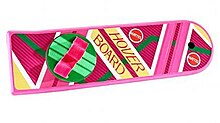Hoverboard
| Hoverboard | |
|---|---|

Fictional hoverboard used by the character Marty McFly in both Back to the Future Part II and Back to the Future Part III.
|
|
| Plot element from the Back to the Future film series | |
| Publisher | Amblin Entertainment |
| First appearance | Back to the Future Part II (2015 in fictional timeline) |
| Created by | Robert Zemeckis |
| In-story information | |
| Type | Personal transport |
| Function | Personal transportation similar to a skateboard, but using a magnetic means of levitation instead of wheels. |
A hoverboard (or hover board) is a fictional levitating board used for personal transportation, first described by author M. K. Joseph in 1967 and popularized by the Back to the Future film franchise. Hoverboards are generally depicted as resembling a skateboard without wheels. During the 1990s there were rumors, fueled by director Robert Zemeckis, that hoverboards were in fact real, but not marketed because they were deemed too dangerous by parents' groups. These rumors have been conclusively debunked. The hoverboard concept has been used by many authors in various forms of media.
The Guinness World Records recognizes the term hoverboard to include autonomously powered personal levitators. In May 2015, the Romania-born Canadian inventor Cătălin Alexandru Duru set a Guinness World Record by travelling a distance of 275.9 m (302 yd) at heights up to 5 m (16 ft) over a lake, on an autonomously powered hoverboard of his own design.
On April 30, 2016, Guinness World Records recognized a new record of 2,252.4 m. The Flyboard Air was powered by jet engine propulsion, and its use allowed Franky Zapata, in Sausset-les-Pins, France to beat the previous record by nearly 2 km. Another method of achieving self-levitation is superconductivity, used by the Slide hoverboard.
Several companies have drawn on hovercraft technology to attempt and create hoverboard-like products but none has demonstrated similar experiences to those depicted in films.
In the 1950s Hiller aircraft produced the "Flying Platform" which was similar to the modern concept of a hover board.
Airboard was unveiled in the 2000 Summer Olympics Opening Ceremony in Sydney, which was manufactured and sold by Arbortech Industries Limited. Series II was unveiled in 2007.
Rumors circulated in 2001 that inventor Dean Kamen's new invention, codenamed Ginger, was a transportation device resembling the Hoverboard. In reality Ginger was the Segway Human Transporter, a self-balancing two-wheeled electric transportation device.
...
Wikipedia
